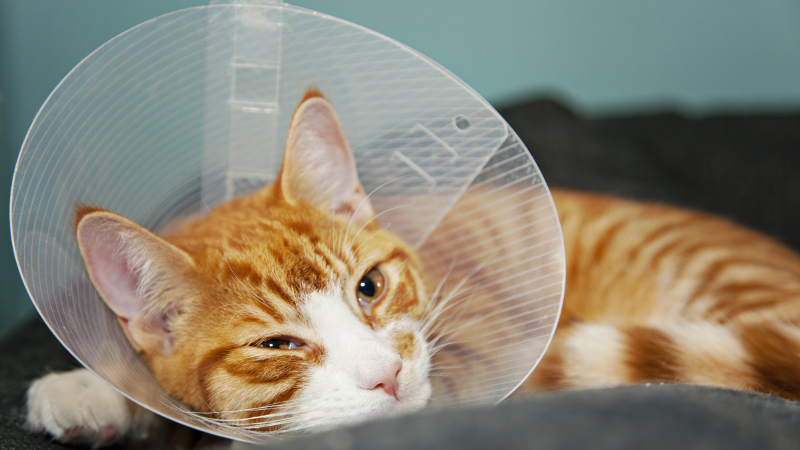
Congratulations on being a responsible pet owner and doing your part to control the unwanted pet population. Most domestic cats are spayed or neutered to help prevent unwanted behaviour, such as urine spraying, and of course mating with other cats.
Spaying or neutering your cat is considered an elective surgery and they are routine for veterinarians to perform. Females cannot get pregnant after being spayed and, within a few weeks post-surgery, male cats can no longer produce sperm after being neutered.
Your surgical discharge kit from the veterinary clinic should include
- Hand-outs that outline the procedure, how to monitor for pain, and aftercare instructions
- Tattoo and microchip information to ensure your pet is registered in the appropriate database
- Pain relief for a few days after surgery
- An Elizabethan collar (“cone”/”lampshade”/”donut”) or onesie to prevent licking
Your pet’s first night post-op
- Most cats are sleepy after anaesthesia. Pets are given a general anaesthesia as part of the spay and neuter procedure. To be discharged, they must be awake enough to walk on their own. Contact your clinic if your pet is pacing, howling, or appears anxious after bringing them home.
- Monitor the appetite. Offer your cat about half of their typical supper meal to see if they are hungry once they get home. Do not change the diet during their recovery period unless recommended by your veterinarian. Your cat’s appetite should be back to normal within a day of surgery. Notify your veterinary team if you see any gagging, vomiting, or diarrhea within that first few days of surgery.
- Where are the stitches? Routine cat neuters do not need sutures at all. Many veterinarians will use dissolvable sutures below the skin for spays; you don’t see much of anything on the surface. The stitches and any tissue glue will dissolve over the next few weeks. Your veterinarian or tech will let you know if there are non-dissolvable stitches or staples in place; these are usually removed 10-14 days after surgery by a member of the clinic team.
- Check the incision. Female cats will have an incision just behind their umbilicus/belly button in the middle of the abdomen. Male cats have will have one or two tiny incisions over the scrotal sac below their anus. Males may have some swelling in the area for a few days, but this goes away on its own within a few days. Any new bruising, redness, or discharge should be reported to your veterinarian as soon as possible.
- Licking does NOT help your cat heal more quickly. Cats who lick at their surgical site may be curious, itchy, or in pain. Licking and chewing at the incision will delay healing and may lead to infection or something known as dehiscence where the whole incision falls apart. Cats who insist on licking should wear their Elizabethan collar or onesie for at least 7-10 days after surgery. If the collar causes panic or distress, call your veterinarian, and ask for calming medication.
- Limit exercise and household activity. Try offering stationary treat puzzles or place a few kibbles in different rooms to encourage surface foraging activities. Confine your cat to a smaller space with food and a litter box when they cannot be directly supervised by a family member. Again, some pets may need calming medications to help limit activity. Your hard work will pay off in having a cat who heals more quickly and without complications.
Use all the pain medication as directed by your veterinarian
Watch for obvious signs of pain, like a hiss when you check their incision, and more subtle signs of pain like droopy whiskers. Remember, even if your cat looks fine after their surgery, it’s important that they take all their recommended pain medication.
